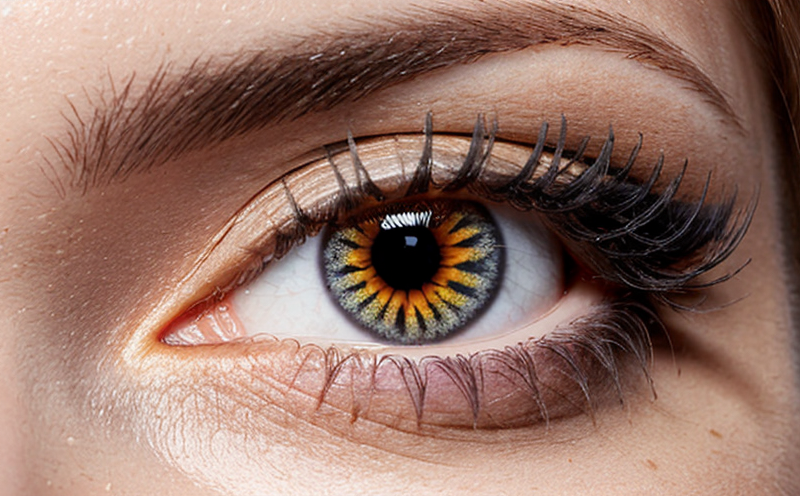Ocular Irritation Testing for Eye Sunscreen Sticks
Eye irritation testing is a critical component of cosmetic product development and regulatory compliance. The purpose is to ensure that products, particularly those intended for direct application near the eyes, do not cause unnecessary discomfort or potential harm when used as directed.
For eye sunscreen sticks, which are designed specifically to protect the delicate skin around the eyes from harmful UV radiation, ocular irritation testing ensures these products meet stringent safety standards. The tests help identify any potential allergens or irritants that could lead to adverse reactions such as redness, swelling, or discomfort.
The testing process involves exposing a controlled amount of the product to human corneal cells in vitro or using animal models for in vivo studies. These methods are designed to simulate real-world usage conditions and provide insights into how the sunscreen stick might interact with ocular tissue.
Key parameters include measuring the extent of cell damage, inflammation, and any other signs indicative of irritation. The testing protocol adheres to international standards such as ISO 10993-10 for biocompatibility assessment and ASTM F2247 for sunscreen products. Compliance with these standards is crucial for ensuring that eye sunscreen sticks are safe and effective.
The results from ocular irritation tests provide valuable information for R&D teams to refine formulations, improve ingredient selection, and enhance product performance. This ensures that the final product not only protects against UV radiation but also meets stringent safety criteria without causing any adverse effects on sensitive ocular tissues.
Quality managers and compliance officers rely heavily on these test results to ensure products meet regulatory requirements in various markets around the world. The data generated from such tests can significantly influence procurement decisions, helping companies source high-quality ingredients and materials that align with their commitment to consumer safety and satisfaction.
Why It Matters
The importance of ocular irritation testing for eye sunscreen sticks cannot be overstated. Consumer safety is paramount, especially when dealing with products designed for areas as sensitive as the eyes. The primary objective is to prevent any potential adverse reactions that could lead to discomfort or long-term health issues.
Consumer trust in cosmetic brands hinges on their commitment to safety and quality. By conducting rigorous ocular irritation tests, companies demonstrate a dedication to producing safe products that meet both regulatory standards and consumer expectations. This not only protects the brand's reputation but also fosters customer loyalty and confidence.
In addition to enhancing consumer trust, compliance with these tests helps brands navigate complex global regulations regarding cosmetic safety. Different regions have varying requirements for product testing, and adherence to international standards like ISO 10993-10 ensures that eye sunscreen sticks are acceptable in multiple markets without the need for additional, potentially costly testing.
From a regulatory perspective, compliance with ocular irritation tests is essential. Non-compliance can result in product recalls, legal action, and damage to brand reputation. By prioritizing these tests, companies avoid such pitfalls and ensure their products are well-received by consumers worldwide.
Quality and Reliability Assurance
- Consistency in Results: Ensuring that test results are consistent across multiple batches of the same product is crucial for maintaining reliability. This consistency allows companies to confidently market their products as safe and effective.
- Traceability of Ingredients: Keeping detailed records of all ingredients used in the testing process ensures traceability, which is vital for compliance with regulatory requirements. This practice also helps identify any potential issues early on, allowing for swift corrective actions.
- Prediction of Real-World Performance: The results from these tests serve as a reliable predictor of how the product will perform in real-world conditions. This predictive capability is invaluable for refining formulations and improving overall product quality.
International Acceptance and Recognition
The testing standards for ocular irritation, such as ISO 10993-10, are widely recognized and accepted across the globe. These standards provide a uniform framework that ensures consistent quality and safety of cosmetic products.
Countries like the European Union (EU), United States, Japan, and Australia have adopted these international standards to ensure product safety. Compliance with such standards not only facilitates easier market access but also enhances brand reputation in these regions.
For companies operating internationally, adhering to these global standards simplifies regulatory compliance processes. This is particularly important for eye sunscreen sticks, which are subject to stringent scrutiny due to their direct contact with sensitive ocular tissues.





